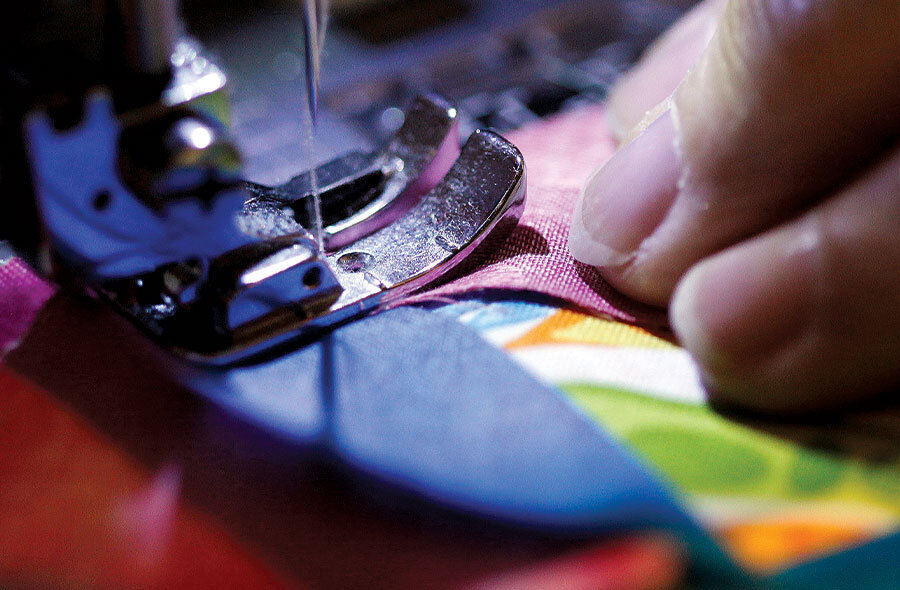My life with a chorus of Singers
Loading...
The only garment I ever designed and sewed on my own – per the unavoidable requirements of my high school home economics class – was a shapeless tent dress, essentially a tube of material with arm and neck holes. When I went to slip it on, I realized I’d stitched the pocket through to the back. After removing the pocket, I modeled the dress (with its two square patterns of holes) before my class of peers, announcing it had cost $1.50 in materials (never mind the hours of tortured, tedious labor). I never wore it again.
I have heard that sewing skills skip a generation, and it must be true, because my mother swiftly and expertly turned out nearly all of my and my sister’s dresses throughout grammar school and into high school: matching pinafores, beautifully smocked; little dirndls; Scottish skirts with matching tams; and an eye-catching pair of bright red silky party dresses. We wore those to a magic show, standing out like twin beacons as the fellow on stage pulled a white rabbit from his top hat. He scanned the rows of children and focused directly on us. Before our parents realized what was happening, “Snowdrop” was ours.
When I won a supporting role in my high school production of the musical “South Pacific,” Mom whipped up a sarong in short order – a beautiful wraparound in bright tropical colors that the director greedily eyed. Would she make one for the lead actress as well? Of course, I volunteered, thinking Mom could find work in the wardrobe department of any Hollywood studio.
She tried to pass on her skills, devoting one summer to helping the three of us, my brother included, stitch together patchwork quilts. It was quiet, absorbing work, cutting up old clothes and arranging the squares into blocks. We all learned to thread the sewing machine – just the kind of puzzle I enjoyed, and I can still picture the basic configuration. But we struggled vainly with the knotty challenges of jammed bobbins, snags, and wandering seams. Again and again, Mom came to the rescue. The quilts survive to this day, but it’s a stretch to claim them as our creations.
Yet I still love the hum and efficiency of the machine under capable hands. One evening years ago, I was walking up from the barn after milking the cows and stopped in my tracks. Charlie’s cousin Eloise, visiting from North Carolina, was framed in the screened window, bent over the Singer she’d packed along in her car.
Aghast to find we had no bathroom curtains – simply a big, bare window overlooking the barnyard – she lost no time finding some material and getting to work. What more homey or welcoming sound on a soft summer evening than that purring machine? We installed the curtains and, after Eloise had left, folded them neatly away in a chest so we could once again gaze from the tub at the herd milling about the barnyard.
I have picked up needle and thread occasionally when a pair of my or my son’s work pants needed patching or hemming. Charlie, for good reason, prefers to mend his own. My mother quickly volunteered to take up the tuxedo trousers my grandson wore in a family wedding a few years ago (no one wanted the young ring bearer sporting my handiwork).
Thinking Connor might take after his great-grandmother and harbor a talent for tailoring, I recently took him to a sewing session at a local children’s museum. There, the 5- and 6-year-old participants made simple potholders by layering precut material into thick mitten-shaped pads. Connor bent over his work with promising absorption. Five or six sewing machines hummed in the background, their operators putting the potholders together. We had the option of using a free machine ourselves or having a volunteer sew Connor’s for us.
Needless to say, I quickly navigated to a woman who sat at a Singer, unengaged and ready to pitch in. She expertly finished the project as we exchanged pleasantries.
Connor stood agape at the needle thrumming and flashing between her fingers as she whipped the little shape around, nonchalantly holding the material taut to complete the thumb seam. Eloise in the window and the endless summer of the quilts came rushing back to me as we left the room to the hum of those machines, which had, in turn, so frustrated and delighted me – depending on who was at the controls.





